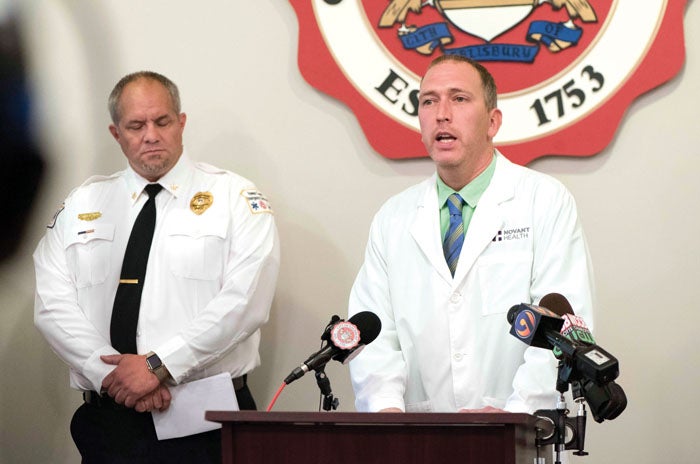Editorial: Sounding the alarm on opioids
Published 12:17 am Sunday, August 6, 2017

- Dr. John Bream, Novant Health Rowan Medical Medical Center's director of the Emergency Department, makes comments in 2017 about the opioid problem. Law enforcement, EMS, Novant Health and Daymark Recovery held a joint press conference to bring to light the large spike in opioid overdoses in Rowan and other counties. Jon C. Lakey/Salisbury Post
Gun violence terrifies neighborhoods and rightfully grabs headlines, but a far deadlier enemy is quietly killing more people in Rowan County than bullets ever have. The culprit is the abuse of opioids — fetanyl-laced heroin, especially. The frequency of overdoses in Rowan County has skyrocketed to a truly epidemic level.
Thursday local authorities and agencies joined forces at a press conference to describe both the breadth and depth of the problem — and the solutions they are working on. For the first time, law enforcement and health care officials joined in warning the public about the deadly opioid threat.
The community may not be able to arrest its way out of this epidemic — or even to treat its way out. But the first step toward conquering the problem is a collaborative effort to sound the alarm, raise awareness and move heroin addiction from the anonymous shadows into the bright sunlight.
One indicator of opioids’ illicit spread is the number of times Rowan County EMS crews have administered Narcan to reverse overdoses. Just looking at one month each year — July — instances in Rowan have jumped from seven in 2015 to 16 in 2016 and a stunning 66 in 2017.
Some 30 people died of opioid overdoses in Rowan last year, many more than were killed by gun shots or in traffic accidents. This year, the problem is exponentially worse.
Catering to Charlotte
In his book, “Dream Land: The True Tale of America’s Opiate Epidemic,” Sam Quinones devotes a chapter to the way heroin traffickers infiltrated Charlotte by targeting well-off young people with money to spend. By 2011, Quinones says, you could buy 15 balloons of potent black tar heroin in Charlotte for $100. That’s $6.50 a dose. Addiction took its toll. Instead of expressing outrage, families who were crushed by grief and the drug’s stigma recoiled from openly talking about their children’s heroin use.
Since then, more people have gotten into the business of selling heroin, often to people who became addicted to over-prescribed painkillers and need a cheaper, more accessible high. Everyone is a target — young, old, rich, poor — and families are beginning to talk openly about the drugs’ devastating effects.
Law enforcement works tirelessly to slow the flood of heroin into the community, but the supply is endless. Meanwhile, demand appears to be growing.
Increase treatment options
Novant Health Rowan Medical Center is to be commended for the plan to expand its 20-bed behavioral health unit to include treatment for addicts and, with the help of the Cannon Foundation, to open an intensive outpatient program targeting substance abuse by the end of the year. Daymark Recovery is working on expanding its Salisbury center.
Will those moves be enough? No. Some communities have gone so far as to provide drug treatment in their jails — an idea Rowan County should investigate.
The opioid epidemic looms over the entire nation and is bigger than any one community. The speakers at last week’s press conference, however, made it clear that Rowan County can’t afford to wait on national solutions. People are dying.


